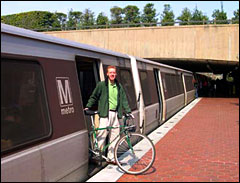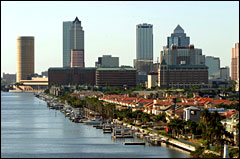For more on Southeast cities, see our full feature on sustainability initiatives underway in Atlanta.
With rapid population growth and increased climate vulnerability, the Southeastern U.S. would seem a prime place for sustainability initiatives. But the area has been slow to cotton on to the greening trend. We chalk it up to the South’s shade-shifting toward red in the last fifty years — aligning with a party that was, until recently, less amenable to environmentalism — and to its rural roots: Conservation issues can seem less dire when you’ve got more cornfields than subdivisions. These days, though, Sun Belt cities are seeing a genteel explosion in green consciousness. Here are just a few examples.

No cars need apply.
Courtesy of Bike Arlington
Arlington, Va. OK, we’re cheating a little by profiling Arlington, which lies just a stone’s throw from smart-city honor student Washington, D.C. But Arlington has a life of its own, and it has taken steps hailed by both the EPA and the Smart Growth Network. So what’s the secret to this Beltway-area success story? Transit, transit, transit. Focusing its mixed-use development around the Metro and other public transit options, it boasts fewer residents relying on driving than the regional average. Forty percent of the population along the local subway corridor takes transit to work, and around 5 percent can walk to work. As a result, while its population has increased over the past 10 years, traffic has remained fairly steady — it’s even decreased on some roads. While carefully planning the development and growth of compact urban villages, Arlington has kept to a goal that would bring a tear to the eye of any smart-growth advocate: becoming “a community where one can live, work, and play … no car required.”

Pardon me boy, is that the Chattanooga future?
Chattanooga, Tenn. Sustainability is nothing new in this mid-sized Tennessee city: In the early 1980s, its leaders began a comprehensive effort to improve the economic, environmental, and social aspects of the place they call home. Through an extensive community-oriented process, Chattanooga revitalized its downtown riverfront, put a new emphasis on developing and renovating affordable housing, worked to amend land-use codes that discouraged mixed-use development, and actively wooed non-polluting industries. Once dubbed the most polluted city in the nation, it not only cleaned up its act by incorporating smokestack scrubbers and electric vehicles into daily life, it began to locally manufacture both products. All of which put it decidedly ahead of the curve in the green-city arena — until enthusiasm for this environmental push waned in the late 1990s amid concerns about job growth. But a recent effort by Mayor Ron Littlefield is putting sustainability back in the spotlight, and Chattanooga is back on track.
 The Big Guava is getting greener.Tampa, Fla. This Florida playground is a prime example of the many cities in the U.S. that are just beginning to think outside the big box. Mayor Pam Iorio and the city council are considering a slew of regulations that would run the gamut of green, from improving the energy efficiency of city operations to waiving permit fees for green construction; from creating an office of sustainability to increasing density. This spring, Iorio issued a policy requiring new city-owned buildings to meet LEED standards. A long-term effort to revitalize the downtown has put housing and transit issues on the table, and an active university community is also focusing the community’s attention on sustainability issues. With a softening economy leading to predictions of a statewide slowdown in population growth after years of boom times, this could be Tampa’s chance to take stock of where it’s been, and where it’s growing.
The Big Guava is getting greener.Tampa, Fla. This Florida playground is a prime example of the many cities in the U.S. that are just beginning to think outside the big box. Mayor Pam Iorio and the city council are considering a slew of regulations that would run the gamut of green, from improving the energy efficiency of city operations to waiving permit fees for green construction; from creating an office of sustainability to increasing density. This spring, Iorio issued a policy requiring new city-owned buildings to meet LEED standards. A long-term effort to revitalize the downtown has put housing and transit issues on the table, and an active university community is also focusing the community’s attention on sustainability issues. With a softening economy leading to predictions of a statewide slowdown in population growth after years of boom times, this could be Tampa’s chance to take stock of where it’s been, and where it’s growing.
